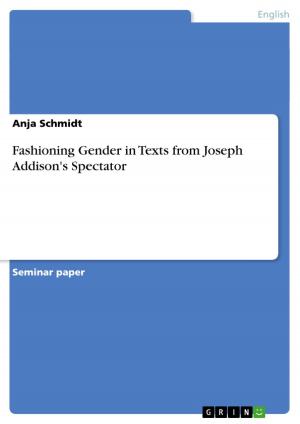The (Mis?)-Representation of Women in Shakespeare's Comedies
Fiction & Literature, Literary Theory & Criticism, British| Author: | Natascha Haas | ISBN: | 9783638293242 |
| Publisher: | GRIN Publishing | Publication: | July 18, 2004 |
| Imprint: | GRIN Publishing | Language: | English |
| Author: | Natascha Haas |
| ISBN: | 9783638293242 |
| Publisher: | GRIN Publishing |
| Publication: | July 18, 2004 |
| Imprint: | GRIN Publishing |
| Language: | English |
Seminar paper from the year 2004 in the subject English Language and Literature Studies - Literature, grade: 1,5 (A), University of Heidelberg (Anglistics), course: Proseminar II: 'Comedies in Shakespeare's Time', language: English, abstract: Compared to other writers of his time, Shakespeare introduced an extraordinary amount of deep female characters in his plays. Because Shakespeare lived in a time when men played the major part in society and the role of women was basically limited to the household, one could easily come to the opinion that he was a reformer whose views were ahead of the Elizabethan times 1 . But is this really true? Does Shakespeare criticize the society he lives in by creating these characters, or do they just serve their purpose to make the plays more dramatic? In this paper, I will first give an overview of the role of women in the Elizabethan age and society. After that I will analyse the female characters of three plays we discussed in the course in order to find out if Shakespeare's views on women diverged from the general view of his time.
Seminar paper from the year 2004 in the subject English Language and Literature Studies - Literature, grade: 1,5 (A), University of Heidelberg (Anglistics), course: Proseminar II: 'Comedies in Shakespeare's Time', language: English, abstract: Compared to other writers of his time, Shakespeare introduced an extraordinary amount of deep female characters in his plays. Because Shakespeare lived in a time when men played the major part in society and the role of women was basically limited to the household, one could easily come to the opinion that he was a reformer whose views were ahead of the Elizabethan times 1 . But is this really true? Does Shakespeare criticize the society he lives in by creating these characters, or do they just serve their purpose to make the plays more dramatic? In this paper, I will first give an overview of the role of women in the Elizabethan age and society. After that I will analyse the female characters of three plays we discussed in the course in order to find out if Shakespeare's views on women diverged from the general view of his time.















